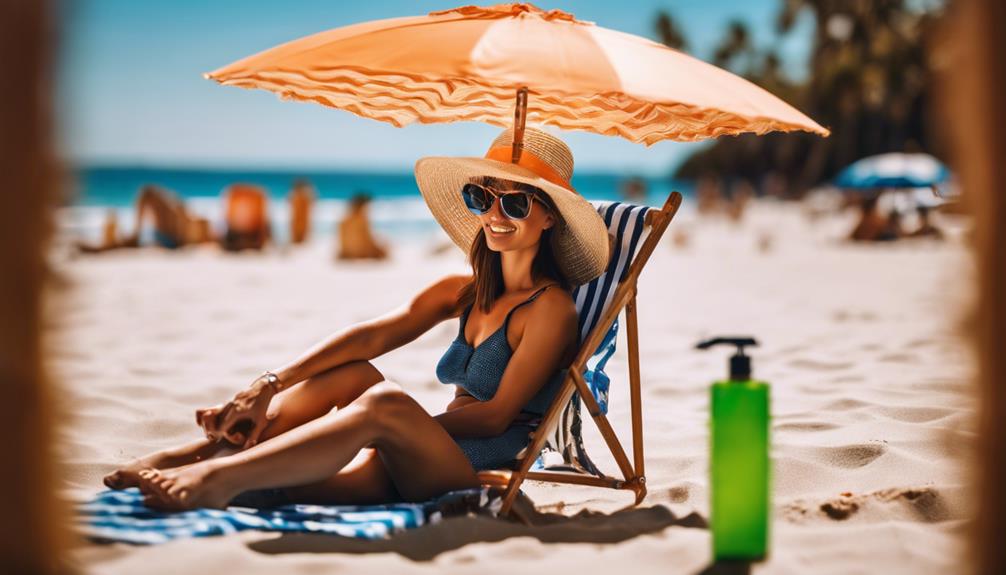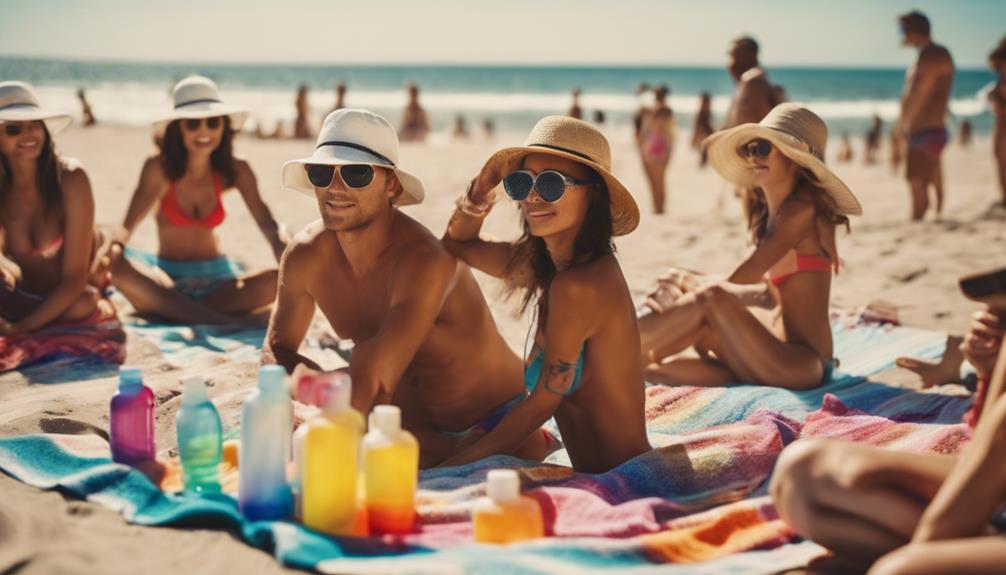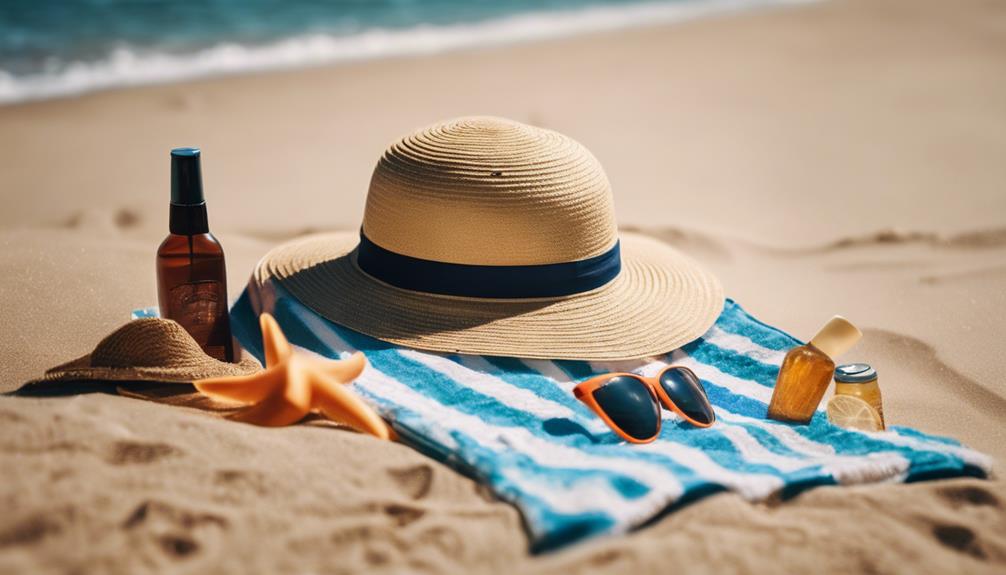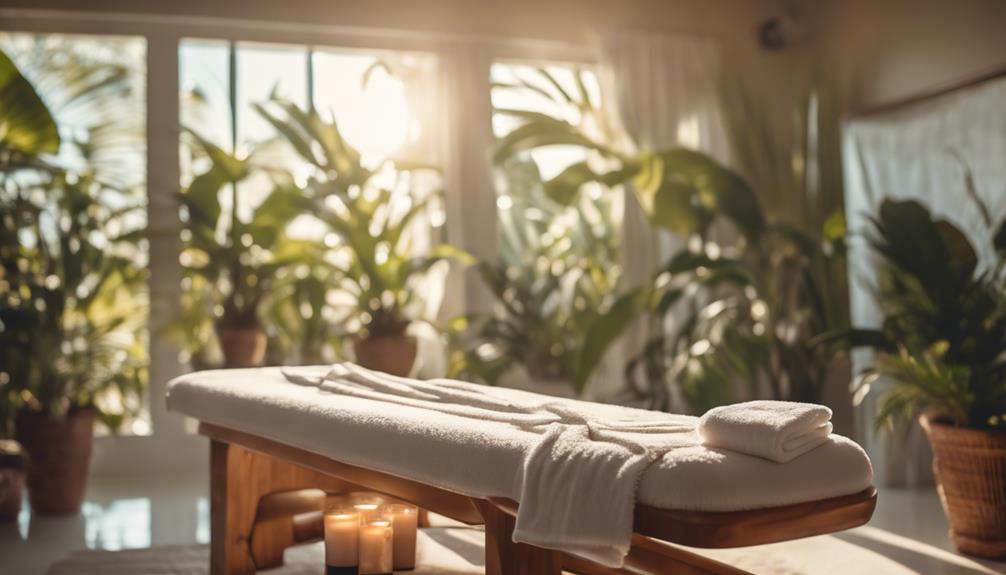Tanning for the first time? Begin by assessing your skin type to determine safe UV exposure limits. Prepare your skin by exfoliating and moisturizing it the day before to achieve an even tan. Don’t forget to wear protective goggles and consider using a bronzing lotion with hydrating ingredients. Keep your tanning sessions short—around 3-5 minutes—to test your skin’s response. Stay hydrated before and after tanning, and watch out for any irritation. After tanning, apply soothing aloe vera to soothe your skin. By following these important tips, you can have a safe and successful tanning experience, and there’s even more helpful information available here.
Key Takeaways
- Begin with short tanning sessions of 3-5 minutes to assess your skin's reaction and avoid irritation.
- Always wear UV-blocking goggles to protect your eyes from harmful rays during tanning.
- Exfoliate and moisturize your skin a day before tanning for an even application and better results.
- Stay hydrated by drinking water before and after tanning to maintain skin health and hydration.
Skin Assessment and Preparation
Before you start tanning, it's important to assess your skin type to create a personalized routine that minimizes the risk of burns and long-term damage.
Understanding your skin's sensitivity to UV rays will help you set appropriate exposure limits.
Prepare your skin by exfoliating, showering, and shaving at least a day before your tanning session. This not only removes dead skin but also promotes an even tan.
Use a lightweight, non-oil-based moisturizer to keep your skin hydrated.
Consulting with tanning experts can provide valuable insights into suitable practices and compatible lotions.
Tailoring your approach will enhance your tanning experience while protecting your skin, ensuring you have a safe and enjoyable time under the sun or in a tanning bed.
Medication Awareness
Understanding the medications you take is vital, as some can increase your skin's sensitivity to UV rays during tanning sessions.
Always consult your healthcare provider to identify any prescriptions or over-the-counter drugs that might heighten the risk of sunburn or adverse reactions.
If you're on medications that affect your skin, time your tanning sessions strategically—opt for moments when these medications are least active in your system.
Additionally, keep your skin well-moisturized before and after tanning to minimize potential irritation.
Wearing protective eyewear is also important, especially if you're on sensitive medications.
Staying informed about how your medications interact with tanning will help you enjoy a safer tanning experience.
Protective Gear

Choosing the right protective gear is essential for ensuring your safety and comfort during tanning sessions. Wearing appropriate gear not only protects your skin but also enhances your overall tanning experience.
Here are three key items you should consider:
- UV-Blocking Goggles: Essential for shielding your eyes from harmful UV rays. Opt for either disposable or durable options to suit your needs.
- Snug Swimwear: Wear snug swimwear or protective clothing to safeguard sensitive areas of your body from overexposure.
- Tanning Stickers: Utilize tanning stickers to monitor your bronzing progress, making adjustments as needed to achieve an even tan.
Lotion Selection and Application
Selecting the right tanning lotion is essential for achieving a safe and effective tan while keeping your skin hydrated. Look for indoor tanning lotions specifically designed for UV exposure, ensuring they contain hydrating ingredients like aloe vera, vitamins, and natural oils.
If you want to enhance your tan, consider bronzing formulas that boost melanin production.
When applying lotion, use circular motions for even coverage, focusing on areas prone to dryness, such as elbows and knees. Avoid overapplication to prevent streaking, and don't forget to wash your hands afterward to prevent orange palms.
Remember, a well-chosen lotion not only helps you tan more effectively but also protects your skin from dryness and damage.
Happy tanning!
Session Guidelines for Newbies

Start your tanning journey with shorter sessions of 3-5 minutes to see how your skin reacts before gradually increasing the duration. It's important to listen to your body and avoid overexposure, especially as a newbie.
Here are some key guidelines to follow:
- Always wear protective goggles to shield your eyes from harmful UV rays during sessions.
- Stay hydrated by drinking plenty of water before and after tanning; this helps maintain your skin's moisture.
- Monitor your skin closely for any signs of irritation or burning, and adjust your tanning time accordingly.
Post-Tanning Care
Proper post-tanning care is essential for soothing your skin and prolonging the benefits of your tan.
Start by applying aloe vera or a gentle moisturizer to hydrate and calm your skin. These products help maintain your tan while preventing dryness.
Drink plenty of water to keep your skin hydrated from the inside out.
Avoid harsh soaps and exfoliants for at least a few days after tanning, as they can strip away your color. Instead, use mild, hydrating cleansers.
Finally, skip the hot showers and sun exposure for a bit to protect your newly bronzed skin.
Pre-Tanning Knowledge

Understanding your skin type is essential for tailoring an effective tanning approach and ensuring a safe, enjoyable experience. Before you engage in tanning, keep these key points in mind:
- Assess Your Skin: Determine if you have fair, medium, or dark skin. This helps you understand how much UV exposure is safe.
- Prep Your Skin: Exfoliate and moisturize at least a day before tanning to achieve an even tan and minimize the risk of burns.
- Consult Professionals: Seek advice from tanning experts about suitable products and techniques tailored to your skin type.
Are the Safety Tips for Tanning Newbies Also Applicable to Protecting My Eyes?
Yes, the same tanning eye safety tips also apply to protecting your eyes from the harmful effects of UV rays during tanning. Wearing UV-protective sunglasses and closing your eyes or using protective eyewear while tanning will help prevent damage. It’s important to prioritize the safety of your eyes when tanning.
Conclusion
So, there you have it! By following these essential safety tips, you can bask in the glorious sun without turning yourself into a lobster or resembling a piece of crispy bacon.
Remember, nobody wants to be the cautionary tale at the beach, right?
Embrace your tanning journey with knowledge, and your skin will thank you later—unless you ignore all this advice, in which case, good luck explaining that sunburn to your dermatologist!










